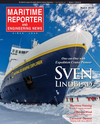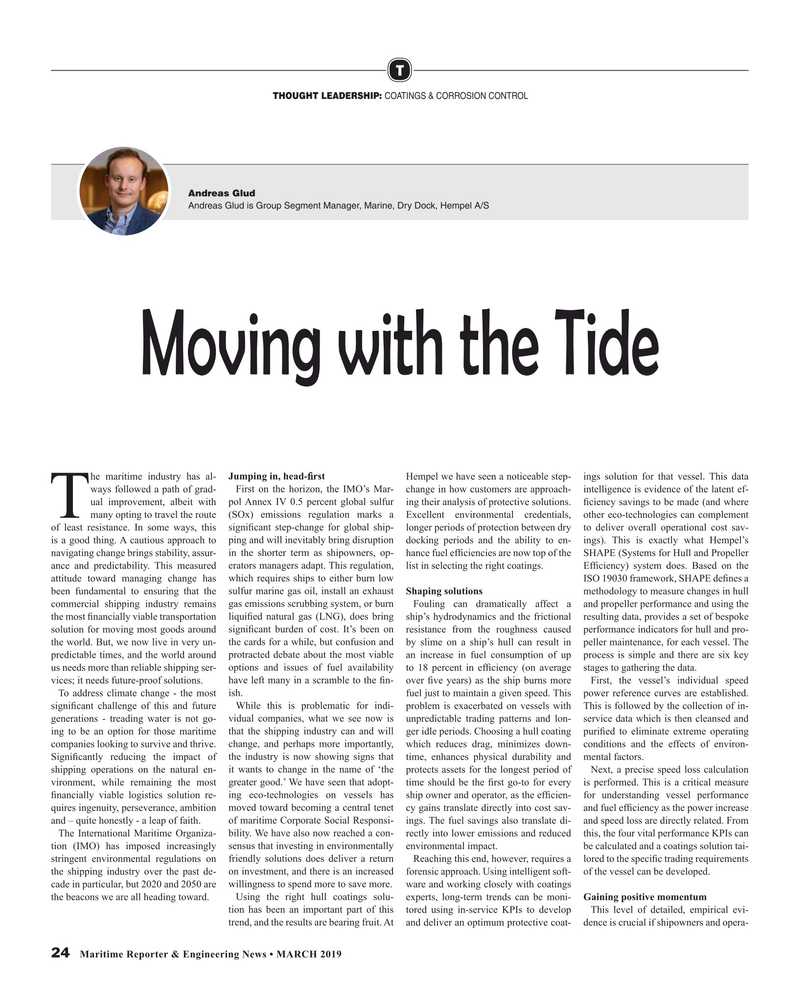
Page 24: of Maritime Reporter Magazine (March 2019)
Cruise Shipping
Read this page in Pdf, Flash or Html5 edition of March 2019 Maritime Reporter Magazine
T
THOUGHT LEADERSHIP: COATINGS & CORROSION CONTROL
Andreas Glud
Andreas Glud is Group Segment Manager, Marine, Dry Dock, Hempel A/S
Moving with the Tide he maritime industry has al- Jumping in, head-? rst Hempel we have seen a noticeable step- ings solution for that vessel. This data ways followed a path of grad- First on the horizon, the IMO’s Mar- change in how customers are approach- intelligence is evidence of the latent ef- ual improvement, albeit with pol Annex IV 0.5 percent global sulfur ing their analysis of protective solutions. ? ciency savings to be made (and where
Tmany opting to travel the route (SOx) emissions regulation marks a Excellent environmental credentials, other eco-technologies can complement of least resistance. In some ways, this signi? cant step-change for global ship- longer periods of protection between dry to deliver overall operational cost sav- is a good thing. A cautious approach to ping and will inevitably bring disruption docking periods and the ability to en- ings). This is exactly what Hempel’s navigating change brings stability, assur- in the shorter term as shipowners, op- hance fuel ef? ciencies are now top of the SHAPE (Systems for Hull and Propeller ance and predictability. This measured erators managers adapt. This regulation, list in selecting the right coatings. Ef? ciency) system does. Based on the attitude toward managing change has which requires ships to either burn low ISO 19030 framework, SHAPE de? nes a been fundamental to ensuring that the sulfur marine gas oil, install an exhaust Shaping solutions methodology to measure changes in hull commercial shipping industry remains gas emissions scrubbing system, or burn Fouling can dramatically affect a and propeller performance and using the the most ? nancially viable transportation liqui? ed natural gas (LNG), does bring ship’s hydrodynamics and the frictional resulting data, provides a set of bespoke solution for moving most goods around signi? cant burden of cost. It’s been on resistance from the roughness caused performance indicators for hull and pro- the world. But, we now live in very un- the cards for a while, but confusion and by slime on a ship’s hull can result in peller maintenance, for each vessel. The predictable times, and the world around protracted debate about the most viable an increase in fuel consumption of up process is simple and there are six key us needs more than reliable shipping ser- options and issues of fuel availability to 18 percent in ef? ciency (on average stages to gathering the data. vices; it needs future-proof solutions. have left many in a scramble to the ? n- over ? ve years) as the ship burns more First, the vessel’s individual speed
To address climate change - the most ish. fuel just to maintain a given speed. This power reference curves are established. signi? cant challenge of this and future While this is problematic for indi- problem is exacerbated on vessels with This is followed by the collection of in- generations - treading water is not go- vidual companies, what we see now is unpredictable trading patterns and lon- service data which is then cleansed and ing to be an option for those maritime that the shipping industry can and will ger idle periods. Choosing a hull coating puri? ed to eliminate extreme operating companies looking to survive and thrive. change, and perhaps more importantly, which reduces drag, minimizes down- conditions and the effects of environ-
Signi? cantly reducing the impact of the industry is now showing signs that time, enhances physical durability and mental factors. shipping operations on the natural en- it wants to change in the name of ‘the protects assets for the longest period of Next, a precise speed loss calculation vironment, while remaining the most greater good.’ We have seen that adopt- time should be the ? rst go-to for every is performed. This is a critical measure ? nancially viable logistics solution re- ing eco-technologies on vessels has ship owner and operator, as the ef? cien- for understanding vessel performance quires ingenuity, perseverance, ambition moved toward becoming a central tenet cy gains translate directly into cost sav- and fuel ef? ciency as the power increase and – quite honestly - a leap of faith. of maritime Corporate Social Responsi- ings. The fuel savings also translate di- and speed loss are directly related. From
The International Maritime Organiza- bility. We have also now reached a con- rectly into lower emissions and reduced this, the four vital performance KPIs can tion (IMO) has imposed increasingly sensus that investing in environmentally environmental impact. be calculated and a coatings solution tai- stringent environmental regulations on friendly solutions does deliver a return Reaching this end, however, requires a lored to the speci? c trading requirements the shipping industry over the past de- on investment, and there is an increased forensic approach. Using intelligent soft- of the vessel can be developed. cade in particular, but 2020 and 2050 are willingness to spend more to save more. ware and working closely with coatings the beacons we are all heading toward. Using the right hull coatings solu- experts, long-term trends can be moni- Gaining positive momentum tion has been an important part of this tored using in-service KPIs to develop This level of detailed, empirical evi- trend, and the results are bearing fruit. At and deliver an optimum protective coat- dence is crucial if shipowners and opera- 24 Maritime Reporter & Engineering News • MARCH 2019
MR #3 (18-25).indd 24 3/6/2019 9:59:52 AM

 23
23

 25
25
